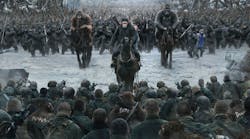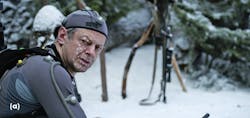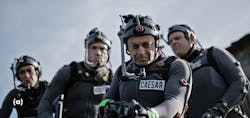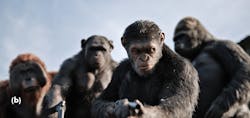Download this article as a .PDF
It’s tough being an ape—especially with Woody Harrelson’s obsessed Colonel McCullough looking to wipe you out. Andy Serkis, as the genetically enhanced ape Caesar, will need a bit of help to turn the tables. “The War for the Planet of the Apes” is the third in the series. Each has been more ambitious from a technical standpoint than the previous version.
This time around, visual effects producer Ryan Stafford had his work cut out for him and his crew. There are more chimpanzees, gorillas, and apes in this movie and the conditions are more complex. Rain and snow have their own challenges, but when the fur is flying it also gets wet (Fig. 1). This required significantly improved software to handle the large number of entities within a frame, such as the battle scenes, as well as the requirement to provide realistic renditions of the non-human characters.
The actors playing the non-human characters often wore cameras on small booms (Fig. 2) so their facial expressions could be properly rendered. The dots on the actor’s face were added daily in the same positions. This approach simplifies generation of the special effects but it can be challenging especially when acting in close quarters. Motion capture also necessitates repeatedly shooting a scene with and without various actors to properly record the background for use when rendering the entire scene.
Computer animation software does a lot of the heavy lifting when it comes to turning actual video into the final product, but there’s still a significant amount of artistry involved because of the level of accuracy that is being delivered in the final film. For example, many shots were done with snow where a trail and footprints need to be properly rendered. The prosthetics used by the actors make much difference paths through the snow. Software does not always handle this adjustment well so artists need to clean up the final version. It is a major logistics challenge.
You will need to check out the “War for the Planet of the Apes” when it opens on July 14th to find out what director Matt Reeves has in store for viewers, as well as how well it will look. Maybe on the second viewing you can look for the visual details. I’m definitely looking forward to it.






